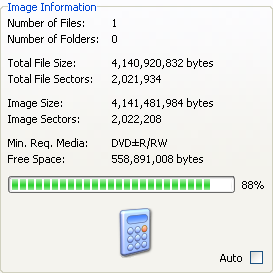-
Posts
30,521 -
Joined
-
Last visited
Content Type
Profiles
Forums
Events
Everything posted by LIGHTNING UK!
-
You'd have to ask that question over at the alcohol forum. ImgBurn doesn't have problems with anything so long as it doesn't mess up basic communication to the drive! If 3rd party apps install drivers (ImgBurn does not) and those drivers mess things up, there's no way for anyone to know. It's just a case of getting the machine back to the stage when it DID work and then perhaps installing normal software until it doesn't - perhaps that's what you did anyway?
-
No it doesn't matter what you're burning. It also doesn't matter if you create the image first or burn on-the-fly, the exact same data is sent to the drive. It just looks to me as if your drive is having mega issues with those discs. In case you've got a dodgy batch of verbatims, perhaps you could buy another lot? You'll use them eventually anyway - right?! If a new batch still won't burn, there must be something up with your drive. As they're only about ?25 now, it's probably cheaper to just buy a new one than it is to keep wasting DL discs!
-
LIGHTNING UK! is my real name, honest! EDIT: Thanks for the donation btw
-
The error you're getting there is more of an OS one than a drive one. I'd go for an uninstall of the IDE controller as per the DMA post in the FAQ. Check for updated motherboard BIOS / chipset drivers / IDE drivers etc. You could also check the cable to the drive is ok and that it's properly configured as master / slave and not on that 'cable select' setting. Is the drive on the proper chipset internal IDE port and not on a 3rd party chipset / PCI IDE controller?
-
If you drop a folder, that folder will exist in the root of the new image/disc - UNLESS it's the only one you drop and you tell ImgBurn that the folder should be the root - i.e. only that folders content is visible on the disc, not the folder itself. So you can drop C:\Data\Movies\Store\Barney and C:\Data\Movies\Angelina and you'll end up with \Barney and \Angelina
-
I burnt my first one of the US ones with the LG Blu-ray burner... I was very happy with the result (It's in the Drives & Media forum if you're interested)
-
I believe the 112 is/should be available now (if not very soon).
-
UDF is just a 'File System' option you'll find on one of the main tabs when in build mode.
-
Maybe it's just getting old? These things do deteriorate out over time
-
It's not 100% accurate (i.e you can't add a file of exactly that 'free space' size due to filesystem overhead etc) but how's this?
-
No, those duplicates are also cell 1 / time 00:00:00 so they're all equal. I would probably just pick the 2nd one so the entire VTS_03 is on the 2nd layer. On a DVD Video disc, the files of a VTS set are ordered as follows: IFO File -> VOB Files -> BUP File..... Next IFO File -> VOB Files -> BUP File.... Next IFO Files -> VOB Files -> BUP File etc etc.
-
'Medium Not Present' = No disc in the drive. Put a disc in it and make sure it's one the drive actually supports. Lots of people buy DVDs and expect them to burn in their CD burners - they of course, will not! (That's what corny is hinting at in his post above) EDIT: No you don't have a DVD burner, just a CD burner. If you want to burn DVD's you'll need to buy a new drive.
-
Yeah that's how RAM discs work. 3x doesn't mean 3x at all, it's all a big con! The only RAM with usable speeds are the 12x ones and of course we can't get 12x media here in europe, it's only available in Japan Still, if you think 3x is slow, imagine how slow 1x discs are Sorry, I didn't get the whole 'not burning the disc again between firmware changes' thing. I wonder why they'd have messed with the read stuff?! What I said still holds true though. My NEC kept failing the software verify when fast write was enabled- and I only ever have official firmware on my drives - the test results would be useless as 'real world' examples otherwise.
-
Actually I'd found the NEC's to be pretty shit at burning RAM discs with that 'Fast Write' option enabled, I don't think it's just you (or the 1-02 firmware). My Pioneer worked fine, as did my LG. Not sure if I tested my LiteOn. The NEC failed every single time though. If the verify fails, the data is wrong - end of story! Of course you can double check by repeating the verify (via the standalone method) and seeing if the errors are in the same places. It *could* just be a flakey read but it's more likely that the drive didn't write the data properly. Obviously DVDRAM does it's own verification during writing, the fast write thing basically enables 'Streaming' mode for the drive which has the effect of disabling the drives internal verification routines (and tells it to do whatever it takes to maintain a steady stream - even writing utter crap to the disc!). With the NEC, it's better to leave 'Fast Write' disabled and disable ImgBurn's verify - to save doing it twice! (you don't need hardware verify + software verify )
-
If it's 00:00:00 in the main PGC, or at least on a cell that's not duplicated in other PGCs (you'd probably notice duplicate entries with the same LBA value) then that's equally as good as the IFO/BUP start ones. If the 00:00:00 one does have duplicate entries and the others aren't also 00:00:00 (i.e. they're somewhere in the middle of the PGC), go for the ifo/bup one. Clearly the layerbreak point at the start of an IFO/BUP means that file's data will be the first thing on the 2nd layer. For the other entries (ones with times) it means some part of the VTS set (the bunch of vobs) will be the first bit of data on the 2nd layer. If the layer switch isn't part of the vobs, there's no way it can cause a glitch during playback. ok?
-
In a very generic sense, if you don't have a VIDEO_TS.IFO file in your VIDEO_TS folder, the VIDEO_TS folder doesn't have all the files in it that it should do.
-
Because it's useful when selecting the best place for a layerbreak.
-
So far as ImgBurn is concerned, they basically want you to do a full erase and then run discovery mode to set all the sectors to '0'. You'll then have to do an erase again to make the disc writable.
-
Make sure you verify the disc as part of the burn process. At least then you'll know that the drive can read what it just wrote. Once we know it can, we'll look at why windows can't see it.
-
There's something odd that's happened recently that causes the exe compressor used on ImgBurn.exe to crash on startup as it tries to decompress the real ImgBurn.exe. Nobody knows the exact reason / cause and it only happens on some machines. I just hope the next version will be ok!
-
File splitting is mainly for people that like to limit the maximum size of files on their hdd (or need to - i.e. in the case of FAT32 not supporting files > 4GB in size). I guess you could always have it split in 4 GB chunks and then put those chunks on a disc. That is to say you make an ISO around part of an ISO! Of course you'd still need the entire set to be able to read any of the data and you'd need to somehow get all the files in 1 location somewhere to do that. I believe there's a program called 'Burn to the brim' that might help you sort out what to add to the disc each time - if you do decide to go the manual route.
-
ImgBurn doesn't split it, you need to do that yourself. So instead of selecting 20GB of data, select 4GB, burn 1st disc, select the next 4GB, burn 2nd disc etc. Or go looking round for a proper backup tool that supports burning to DVDs.
-
It'll be tomorrow before I'm on here again so I might as well just say 'Happy Birthday' now! Happy Birthday!!
-
I would think the drive has written to those discs so they're useless now I'm afraid. Hmmm.... 'Test Mode'... it varies from drive to drive. Some are better at doing a fake burn than others and will pick up on more potential issues.
-
Yup, the first thing I'd do is update the firmware. TYG03 are of course 16x media. The 1.03 firmware is saying they're only supported at 8x for some reason. I'm sure this will be fixed in the latest (1.10 or something?) version. Windows or the drivers basically took the drive offline because it was erroring out. When that happens, Windows broadcasts a device removal message. ImgBurn picks up on this and tells you about it in the log.



